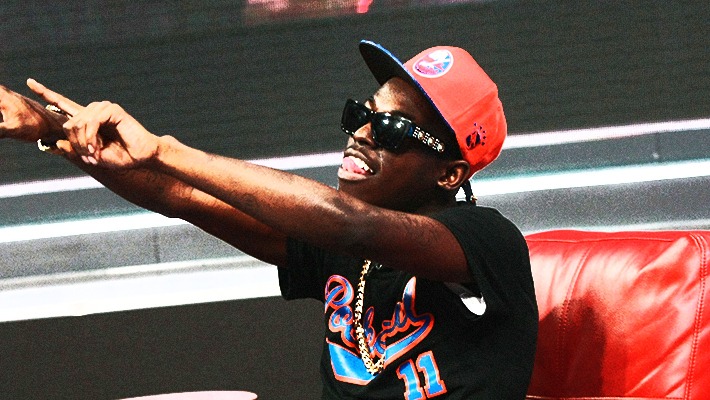The last time Bobby Shmurda had an inescapable hit was the summer of 2014 — nearly seven years ago. That was the summer of “Hot N****,” which climbed to No. 6 on the Billboard Hot 100 — before the rules changed that allowed the publication to count streams — launched the “Shmoney Dance” meme, and spawned seemingly dozens of freestyles and remixes featuring everyone from Chicago drill upstarts to New York ’90s legends. There’s even a reggae remix featuring Junior Reid and Popcaan.
But then his GS9 crew was scooped up by the NYPD on a truly dizzying array of crimes all bundled into a racketeering charge that claimed GS9 was a drug-dealing, war-waging gang. Bobby’s own words were used against him as the prosecution used clips of “Hot N****” to bolster its accusations. “I been selling crack since like the fifth grade,” Bobby boasts on the song. Despite the Supreme Court’s previous decision that lyrics can’t count as evidence, Bobby’s case lawyer felt strongly enough that Bobby — and his GS9 cohorts, including fellow rapper Rowdy Rebel — would lose that the rapper pled guilty to one count of third-degree conspiracy and one count of weapons possession, receiving five years in prison, after time already served.
Those five years ended this week, to the jubilation of “Hot N****” fans and Bobby’s friends in the rap game, including Rowdy and Migos member Quavo, who vowed to pick him up from Clinton Correctional Facility upon his release. He emerges to exuberant celebrations on social media and tempered excitement for new music, but that begs the question: Can he recover the momentum he lost during his six-year stint behind bars, especially in a music world that has so thoroughly moved on from the specific moment in time that he could rightfully say he owned?
For one thing, the driving force behind the success of “Hot N****” was Vine, the now-defunct social app that turned six-second video clips into pop culture meme fodder. A snippet of Bobby’s “Hot N****” video, in which he removes his ball cap and flings it into the air before beginning a hip-gyrating “Shmoney Dance,” amused users who jokingly pondered the hat’s whereabouts and shared the clip widely on other services, making Shmurda as close to ubiquitous as a character can be in today’s dearth of monoculture.
Vine has largely been replaced by TikTok, an app that plays by its own unique set of rules, mostly populated by and driven by users who may not even remember the days of “Hot N****” or the circumstances of Bobby’s disappearance from the public eye. The sounds that attract TikTok users are goofier than the menacing, booming Jahlil Beats production that backed “Hot N****.” The dances are mostly performed by the users themselves, in complicated choreography reminiscent of the Japanese “Para Para” synchronized dance style.
For another thing, that “Jahlil Beats, holla at me” tag hasn’t been heard on a Billboard hit since 2016. The prevalent sound of Bobby’s Brooklyn stomping grounds is Drill, inspired and produced mainly by London beatmakers like Axl Beats and Melo808. These producers craft sparse compositions with skittering drums and airy, haunting samples, similar to Jahlil’s cavernous cacophonies but stripped back, almost all low-end with few bells and whistles. Fortunately for Bobby, he seems suited to this style and has a toehold in the scene thanks to Rowdy Rebel’s appearance on the posthumous 2020 Pop Smoke song “Make It Rain,” so the GS9 boys might not be total strangers to Drill fans.
However, the intervening six years of Bobby’s sentence has seen changes to distribution models, an increase in streaming, cultural changes in the usage of social media, and of course, several new artists who have cropped up to fill the already saturated hip-hop market. There are even more voices to fight through for exposure, with even more avenues for those voices to be heard, and tastes that have changed drastically from the days when Bobby graced the cover of XXL’s 2015 Freshman issue. Half the rappers who joined him on that cover have since faded from public favor, while in the intervening years, the SoundCloud rap scene popped off, women have come to dominate the charts, and fans have gravitated to ever more melodic-sounding artists.
That said, there’s precedent to believe in a comeback. Artists going away as publicly as Bobby did often builds myth and mystique. When artists are plucked away in their prime, music fans often feel a sense of loss that can drive anticipation for a comeback. Tupac’s All Eyez On Me is one example of an artist’s triumphant return from prison; while more recent examples are less stark, artists like Gucci Mane, Lil Wayne, and T.I. returned from shorter stints to respectable careers driven by each artist’s prolific output and cult status, even if their mainstream acceptance was somewhat dulled by the time away.
It’s possible that Bobby can adapt to all these changes to reclaim his grip on the playlist-based Billboard charts, reassert his social media presence, and pick up right where he left off. However, it’s equally possible that the world continues to pass him by, save for a loyal niche following that sees him as more than a meme and contributed to the plays of his meager discography past “Hot N****” and “Bobby Bitch.” The wide-open nature of this new frontier is both a blessing and a curse, but at least Bobby Shmurda has the freedom to explore its possibilities.

